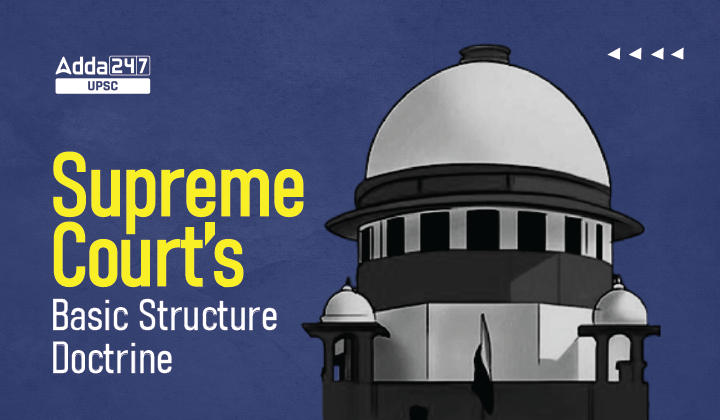Table of Contents
Supreme Court’s Basic Structure Doctrine – Relevance for UPSC Exam
General Studies II- Polity
Context
- The basic structure doctrine constitutes a high watermark in the assertion of the Supreme Court’s judicial power in the teeth of a determined majoritarian regime.
What is basic structure of Constitution?
- The basic structure doctrine is one of the fundamental judicial principles connected with the Indian Constitution.
- The doctrine of the basic structure holds that there is a basic structure to the Indian Constitution, and the Parliament of India cannot amend the basic features.
Basic Structure of Constitution: Significance
- The doctrine of basic structure is nothing but a judicial innovation to ensure that the power of amendment is not misused by Parliament.
- The idea is that the basic features of the Constitution of India should not be altered to an extent that the identity of the Constitution is lost in the process.
Basic Structure of Constitution: Background
- Courts are empowered under our Constitution to invalidate not only executive orders, but also legislative enactments that violate any part of the Fundamental Rights guaranteed in Part III of the Constitution (Bill of Rights).
- But as to whether they are also empowered to adjudicate on the validity of constitutional amendments passed with the requisite special majority and following the procedure prescribed in Article 368 the Constitution is silent.
Basic Structure of Constitution: Historical developments
Constitution provided a mechanism for parliament to amend the constitution in the form of article 368 but the nature and scope of this amending power was questioned in Supreme Court on many occasions.
Supreme Court gave a series of judgement which ultimately culminated in probably the most landmark judgement- The Basic structure doctrine judgement.
- Shankari Prasad Case- 1951
- Golakh Nath Case- 1967
- Kesvananda Bharati Case- 1973
- Minerva Mills case- 1980
- I.R. Coelho- 2007
Relevant articles to look
- Art 13(2) – Any LAW abridging fundamental rights mentioned in part 3 shall be null and void to the extent of contravention
- Art 368 -Procedure to amend the constitution.
- Art 19(f) – freedom to acquire hold on and dispose of property.
- Art 31 – Right to property
The rights were subject to reasonable restriction in public interest and restriction were subject to judicial review.
Important Judgements
Shankari Prasad v. Union of India (1951)
In this case, the constitutional validity of the First Amendment Act (1951), was challenged.
- The Supreme Court ruled that the power of the Parliament to amend the Constitution under Article 368also includes the power to amend Fundamental Rights.
- The word ‘law’ in Article 13 includes only ordinary laws and not the constitutional amendment acts (constituent laws).Therefore, the Parliament can abridge or take away any of the Fundamental Rights by enacting a constitutional amendment act and such a law will not be void under Article 13.
Golaknath v. State of Punjab (1967)
In that case, the Supreme Court ruled that the Parliament cannot take away or abridge any of the Fundamental Rights.
- The Court held that theFundamental Rights cannot be amended for the implementation of the Directive Principles.
- The Parliament reacted to the Supreme Court’s judgement in the Golaknath Case (1967)by enacting the 24th Amendment Act (1971) and the 25th Amendment Act (1971).
- The 24thAmendment Act declared that the Parliament has the power to abridge or take away any of the Fundamental Rights by enacting Constitutional Amendment Acts.
- The 25thAmendment Act inserted a new Article 31C which contained the following two provisions:
- No law which seeks to implement the socialistic Directive Principlesspecified in Article 39 (b) and (c) shall be void on the ground of contravention of the Fundamental Rights conferred by Article 14, Article 19, or Article 31.
- No law containing a declaration for giving effect to such a policy shall be questioned in any courton the ground that it does not give effect to such a policy.
Kesavananda Bharati
- He challenged the Kerala land reforms legislation in 1970,which imposed restrictions on the management of religious property.
- The case waschallenged under Article 26, concerning the right to manage religiously owned property without government interference.
-
- The landmark judgement was delivered on 24th April 1973 by a thin majority of 7:6 wherein the majority held that any provision of the Indian Constitution can be amended by the Parliament in order to fulfil its socio-economic obligations that were guaranteed to the citizens as given in the Preamble, provided that such amendment did not change the Constitution’s basic structure.
- The minority, however, in their dissenting opinion, were wary of giving the Parliament unlimited amending power.
- The court held that the 24th Constitutional Amendment was entirely valid. But it found the second part of the 25th Constitutional Amendment to be ultra vires.
- The Supreme Court declared the Article 31C as unconstitutional and invalid on the ground that judicial review is basic structure and hence cannot be taken away.
- Despite the ruling that Parliament cannot breach fundamental rights, the court upheld the amendment that removed the fundamental right to property.
- The court ruled that in spirit, the amendment would not violate the “basic structure” of the Constitution.
Minerva Mills v. Union of India (1980)
Main Theme: The Supreme Court reiterated that Parliament can amend any part of the Constitution but it cannot change the “Basic Structure” of the Constitution.
- In the Minerva Mills case,the Supreme Court held that ‘the Indian Constitution is founded on the bedrock of the balance between the Fundamental Rights and the Directive Principles.
- They together constitute the core of the commitment to social revolution.
- The goals set out by the Directive Principles have to be achieved without the abrogation of the means provided by the Fundamental Rights.
- Therefore, the present position is that the Fundamental Rights enjoy supremacy over the Directive Principles.
- Yet, this does not mean that the Directive Principles cannot be implemented.
- The Parliament can amend the Fundamental Rights for implementing the Directive Principles,so long as the amendment does not damage or destroy the basic structure of the Constitution.
Conclusion
- By restraining the amending powers of legislative organ of State, Supreme court provided basic Rights to Citizens which no organ of State can overrule. Being dynamic in nature, it is more progressive and open to changes in time unlike the rigid nature of earlier judgements.




 TSPSC Group 1 Question Paper 2024, Downl...
TSPSC Group 1 Question Paper 2024, Downl...
 TSPSC Group 1 Answer key 2024 Out, Downl...
TSPSC Group 1 Answer key 2024 Out, Downl...
 UPSC Prelims 2024 Question Paper, Downlo...
UPSC Prelims 2024 Question Paper, Downlo...
